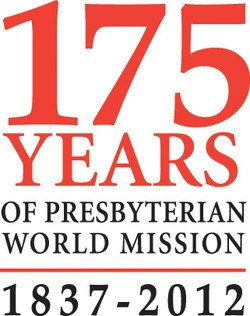The year 2012 marks 175 years of Presbyterian World Mission; but the denomination’s commitment to mission is considerably older than this, and much of this history is rooted in Western Pennsylvania.
The General Assembly held in Philadelphia in 1837, chiefly remembered for the church schism between Old School and New School that occurred there, is also notable for launching the first national Presbyterian mission board, the origin of today’s Presbyterian World Mission (PWM). A highly controversial decision in a GA torn by controversy, it was the result of an overture made by the Synod of Pittsburgh, which proposed that the national church adopt the Western Foreign Mission Society, the synod’s missionary-sending organization.
Western Pennsylvania pursues mission
Though Presbyterians can trace their origins in North America to the earliest settlements in New England, it was the great migration of Scots-Irish in the eighteenth century that inflated their numbers, making Presbyterians one of the largest denominations in the colonial era. Some of these immigrants decided to travel west beyond the Allegheny Mountains where land was cheap.
The year 1758 saw the temporary healing of the Presbyterian schism between the Old Side and New Side with the formation of the Synod of New York and Philadelphia. Seizing the opportunity to promote Presbyterianism in western Pennsylvania, the synod employed army chaplains and ministers to work in the area to establish churches among the new settlers. In 1781 this resulted in the establishment of the Presbytery of Redstone, which included a huge area; and as the population increased and churches grew, Redstone was subdivided into a number of new presbyteries.
When the Synod of Pittsburgh was established in 1802, the new body passed a resolution committing itself “to diffuse the knowledge of the gospel among the inhabitants of the new settlements; the Indian tribes, and if need be, among the interior inhabitants, where they were not able to support the gospel.”
The missionary spirit of Presbyterians in western Pennsylvania must also be seen in the light of the larger Protestant mission movement in the first half of the nineteenth century. William Carey had launched this movement in 1793 with the establishment of the Baptist Missionary Society in England. The idea crossed the Atlantic in the first decade of the new century with the famous Haystack Prayer Meeting in 1806 at Williams College, Massachusetts, which four years later issued in the establishment of the American Board of Commissioners for Foreign Missions. Though largely an independent mission society of the Congregational churches, the American Board was a non-denominational mission society, and many Presbyterians supported its work.
The controversy: do Presbyterians need their own mission board?
For Presbyterians the existence of the American Board raised an important theological question: Can the work of mission be rightly relegated to an independent society (essentially a para-church organization), or should it be seen as integral to the nature of the church and therefore an enterprise of the denomination? Those who took the former view, it was argued, might see mission as something that individual Presbyterians and congregations can do on an optional basis. Those who took the latter view saw mission as at the heart of what it means to be the church of Jesus Christ.
Overtures were presented to General Assemblies in 1812, 1828, and 1831 that called for the establishment of a Presbyterian mission board. The issue, unfortunately, became part of a new division of the time between the Old School and New School wings of the church. Those in western Pennsylvania who sided with the Old School also urged the General Assembly of 1831 to embrace a “conceptional change” in mission thinking. When their overture failed, the Synod of Pittsburgh chose to create its own mission organization, the Western Foreign Missionary Society, to be headed by Dr. Elisha P. Swift, an instructor at Western Seminary (one of the original institutions that later became Pittsburgh Theological Seminary).
The Western Foreign Missionary Society sent its first missionaries to Monrovia, Liberia, and Lodiana in the Punjab of North India (now Pakistan). The society also sent 21 missionaries to Native American tribes, and 39 missionaries to Liberia and India.
Presbyterian mission and Western Pennsylvania
At the Philadelphia General Assembly of 1837 the theological dispute between the Old School and New School resulted in a second schism. The Old School wing adopted the Western Foreign Missionary Society as its denominational mission organization, changing its name to the Presbyterian Board of Foreign Missions and moving the headquarters to New York. The New School denomination chose to continue to send missionaries through the American Board. However, by the time this latest division in the denomination was healed in 1869, the New School had already begun to support the denomination’s mission board.
Western Pennsylvania has always been an important supporter of denominational mission, and strengthened by churches from the United Presbyterian Church of North America that joined the denomination in 1958, it has a strong record of missional engagement in Egypt, Sudan, Ethiopia, Pakistan, and other nations. This region has contributed some of the great Presbyterian pioneer missionaries, such as John C. Lowrie in India, John Kelly Giffen in Sudan, and Don McClure in Ethiopia. All of these graduated from one of the progenitors of Pittsburgh Theological Seminary, which continues to emphasize mission in its program.

